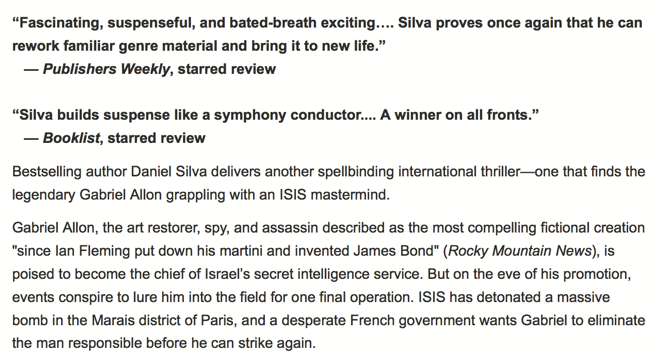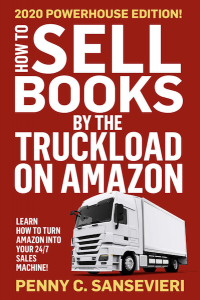
Today’s guest post is an excerpt from How to Sell Books by the Truckload on Amazon: 2020 Updated Edition by Penny Sansevieri (@Bookgal).
Whether we’re talking about Amazon, or any other online retailer, book descriptions are more important than most authors realize. Too many times I see blocks of text pulled from the back of the book. In theory, it’s not the worst idea. However, it may not be the greatest idea if your book description isn’t strong to begin with, or if the book details are just slapped up on Amazon without any attention to spacing, bulleting, short paragraphs, and bold face.
We’ll discuss some ideas about book descriptions specifically, and then how to enhance your own book description for maximum effectiveness on Amazon.
Is Your Book Description Memorable Even If Scanned?
Most people don’t read websites; they scan. The same is true for your book description. When your description is visually and psychologically appealing, it invites the reader to delve in instead of click off. Huge blocks of text can overwhelm.
Even on sites like Amazon—where consumers go to buy, and often spend a lot of time comparing products and reading reviews—it’s important to keep in mind that most potential readers will move on if your description is too cumbersome. So how can you make your description more scan-friendly?
- Headlines: The first sentence in the description should be a grabber, something that pulls the reader in. This text could also be an enthusiastic review quote or some other kind of endorsement, but regardless, it should be bolded. In the case of your Amazon book page, you could also use the “Amazon Orange” to set your headline apart from the rest of the text.
- Paragraphs: Keep paragraphs short, two to three sentences max.
- Bolding: You can boldface key text throughout the description. In fact, I recommend it. Just be sure you aren’t using boldface too much. Don’t highlight two or three sentences in bold, because it’ll have more impact if you do just one sentence or a few keyword strings.
- Bullets or numbers: If your book is nonfiction, it can be very effective to bullet or number as much of your information as possible. Take key points and the “here’s what you’ll learn” elements and put them into a bullet point/numbering section that’s easy to scan and visually appealing.
Writing Descriptions for Nonfiction
It’s likely that whomever you’re targeting already owns a few titles similar to the one you just wrote. So why should they add yours to their collection? While you’re crafting your book description, keep in mind that you’re likely serving a very crowded market. You need to be precise and vividly clear about why your book matters.
Nonfiction shoppers often look for the solution to a problem. So your book description needs to zero in on what that problem likely is. Plus readers need to feel like you understand them, and they need to be convinced you’re the best person to help them work through it. If you’re a noted expert in your field, with accolades to back it up, work those in briefly, because it truly does set you apart. So do reviews by other experts in your field or industry, but keep them short and sweet—excerpts of the best parts are plenty. Save your full bio and complete reviews for the other sections that Amazon gives you.
Writing Descriptions for Fiction
Fiction is a bit tougher, because it’s easy to reveal too much, or not quite enough. For this reason, I encourage you to focus on developing your elevator pitch. Every other piece of the story anchors to that.
For our purposes, the elevator pitch is the briefest of the brief descriptions you will develop. Elevator pitches are important because there are times when you need to capture someone’s attention with a very short, succinct pitch.
And why does this matter for your book description? Because having a short hook is an excellent way to start building your book description. Elevator pitches focus on the core of your book—the one element that your book could not be without—and that’s what matters most to your reader.
When it comes to fiction, buyers have a lot of options, so your opening sentence should be the best you’ve got—because it might be the only chance you get. And don’t confuse not giving it all away with being vague. If you’re vague, the potential reader won’t experience the emotional connection they need that makes them want to find out more. So give them a story arc to latch onto and leave them needing more.
Writing Descriptions for Children’s Books
Make sure to include the intended age range. Even though you can add it in the Amazon details, I’ve had parents tell me that seeing it in the book description is incredibly helpful, because if anyone is short on time and needs help making smart buying decisions, it’s parents. It also helps a lot to let parents know right away what their child will learn, or what discussions or themes the book will highlight. While you wrote the book for children, you’re selling it to adults, so don’t oversimplify your description, thinking you’re off the hook.
Include Top Keywords
Keywords are as important to your Amazon book page as almost anything else. I’ve written a lot about Amazon-specific keyword strings that you can see on our blog: Demystifying Amazon Categories, Themes, and Keywords, but here’s a quick overview:
The term “keyword” is actually inaccurate, because readers don’t search based on a single keyword. Think instead of keyword strings.
For example, “Romance about second chances” or “Second-chance romances,” have been popular search strings on Amazon for a while now. However, by taking that sentence and inserting it into your book description, you can help boost your visibility on the site, as well as keying into your readers’ specific interest. If they’re searching for, “Romance second chances,” and they see it in your book description, it’s going to ping them with: “Oh! This is the exact book I’ve been looking for.”
That said, it’s a good idea to avoid overstuffing your book description with keywords. I recommend finding six or seven strings and using them sparingly throughout.
Update Your Book Description Often
Here’s something you may not have considered: Your page isn’t set in cement. In fact, ideally, it shouldn’t be static. When you get good reviews and awards, update your book page to reflect that. When you do your keyword string and category research every quarter (yep, put it on the list), consider whether there are any new ones you can sprinkle throughout the different sections.
Here’s a Model to Follow
Take a look at the book description below from Dan Silva. It’s a great example of a blurb that combines great review quotes with a book description that pulls you in from the first sentence.
Book blurbs are eye candy, because people like what other people like. Even if you don’t have review quotes from highly respected or recognizable publications such as Booklist and Publishers Weekly, you should still add reviews. Just be sure to cite them correctly.

 Notice how they are boldfaced to draw attention to them? And check out the second paragraph. Whoever wrote this book description inserted a review to help bolster the character description, which is another clever idea.
Notice how they are boldfaced to draw attention to them? And check out the second paragraph. Whoever wrote this book description inserted a review to help bolster the character description, which is another clever idea.
Note from Jane: If you enjoyed this post, check out How to Sell Books by the Truckload on Amazon: 2020 Updated Edition by Penny Sansevieri.
Penny Sansevieri, CEO and founder of Author Marketing Experts, Inc. (AME) and Adjunct Professor at NYU, is a best-selling author and internationally recognized book marketing and media relations expert. Her company is one of the leaders in the publishing industry and has developed some of the most cutting-edge book marketing campaigns. To learn more about Penny’s books or her promotional services, visit Author Marketing Experts (AME).

I’ve read advice to use the keywords designated in book info/metadata in the book description. I’ve also read the opposite advice: don’t use keywords from the book info/metadata in the book description because you’re wasting those keywords. Same with whether keywords should include words from the book title — I’ve seen opposite advice there as well. Thoughts?
Jean hi – I don’t know how you’d be wasting keywords by using them in the book description. You aren’t limited in the use of them, meaning you can include them and aren’t penalized for it. That said, I always use them in book descriptions – whenever possible. Good luck!
Great post! But what do you mean by “… use the ‘Amazon Orange’ to set your headline apart from the rest of the text.” You cannot add color here, can you? (I don’t see it on your book, nor Dan Silva’s) Or am I missing something?
Harald hi there, great question! Yes, you can use Amazon orange, via the HTML coding that’s in my book. So, bolding in color is possible. It’s in the new book – if you are reading it on Kindle just search it and it should pop up. If you don’t see it, ping me back in comments and I’ll find it!
Maybe we’re talking about different things? I’m looking at your book descriptions on Amazon for “Truckload” and both Kindle and Pbk descriptions have all text in black. I do see your use of H2/H4 tags (and bolding) but definitely no colors showing. Can you clarify? Thanks.
I chose not to use those particular tags for those descriptions – that was my reasoning. I felt, just in particular for those books, that the black bolded seemed a better fit.
[…] Penny Sansevieri: How to Improve Your Amazon Book Descriptions […]
[…] Most readers will find you online, so make sure to be ready when they come looking. Lee Wind directs us to some excellent author and author/illustrator websites, Julie Valerie explores influencers in the online book world, Stephanie Chandler lists book review options, and Penny Sansevieri tells us how to supercharge your Amazon book description. […]